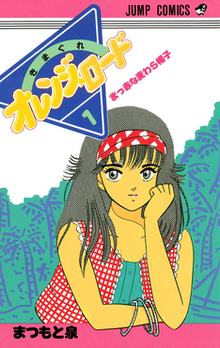
Back الدرب البرتقالية لكيماغوريه Arabic Kimagure Orange Road Catalan Kimagure Orange Road German Kimagure Orange Road Spanish Kimagure Orange Road Finnish Kimagure Orange Road French Kimagure Orange Road Croatian Orange Road Italian きまぐれオレンジ☆ロード Japanese 변덕스러운 오렌지로드 Korean
| Kimagure Orange Road | |
 First tankōbon volume cover, featuring Madoka Ayukawa | |
| きまぐれオレンジ☆ロード (Kimagure Orenji Rōdo) | |
|---|---|
| Genre | |
| Manga | |
| Written by | Izumi Matsumoto |
| Published by | Shueisha |
| English publisher | |
| Imprint | Jump Comics |
| Magazine | Weekly Shōnen Jump |
| Demographic | Shōnen |
| Original run | March 26, 1984 – September 28, 1987 |
| Volumes | 18 |
| Anime film | |
| Shonen Jump Special: Kimagure Orange Road | |
| Directed by |
|
| Produced by |
|
| Written by | Kazunori Itō |
| Music by | Ryō Yonemitsu |
| Studio | Pierrot |
| Released | November 23, 1985 |
| Runtime | 25 minutes |
| Anime television series | |
| Directed by | Osamu Kobayashi |
| Produced by |
|
| Written by | Kenji Terada |
| Music by | Shirō Sagisu |
| Studio | Pierrot |
| Licensed by | |
| Original network | Nippon TV |
| Original run | April 6, 1987 – March 7, 1988 |
| Episodes | 48 |
| Anime film | |
| I Want to Return to That Day | |
| Directed by | Tomomi Mochizuki |
| Produced by |
|
| Written by | Kenji Terada |
| Music by | Shirō Sagisu |
| Studio | Pierrot |
| Licensed by |
|
| Released | October 1, 1988 |
| Runtime | 69 minutes |
| Original video animation | |
| Directed by |
|
| Produced by |
|
| Written by |
|
| Music by | Shirō Sagisu |
| Studio | Pierrot |
| Licensed by |
|
| Released | February 15, 1989 – January 18, 1991 |
| Runtime | 25 minutes per episode |
| Episodes | 8 |
| Anime film | |
| Shin Kimagure Orange Road: Summer's Beginning | |
| Directed by |
|
| Produced by |
|
| Written by | Kenji Terada |
| Music by | Yuki Kajiura |
| Studio | Pierrot |
| Licensed by | |
| Released | November 2, 1996 |
| Runtime | 95 minutes |
Kimagure Orange Road (Japanese: きまぐれオレンジ☆ロード, Hepburn: Kimagure Orenji Rōdo, "Capricious Orange Road")[3] is a Japanese manga series written and illustrated by Izumi Matsumoto. It was serialized in Weekly Shōnen Jump magazine from 1984 to 1987, with the chapters collected in 18 tankōbon volumes by Shueisha. The story follows teenage esper Kyōsuke Kasuga and the love triangle he gets involved in with Madoka Ayukawa, a young heroine with a reputation for being an unpopular loner and delinquent, and her best friend Hikaru Hiyama.
Following a 1985 film pilot (Shonen Jump Special), Toho and Studio Pierrot created an anime television series that was broadcast on Nippon Television from 1987 to 1988. Two more films were released in 1988 and 1996, as well as an original video animation series that began in 1989. In the mid-1990s the series was novelized as well. The manga has been released in English digitally by Digital Manga Guild. The anime television series, second film, and original video animation series were all released in North America by AnimEigo, while the third film was licensed by ADV Films. The anime series is currently licensed by Discotek Media.
Kimagure Orange Road was a highly influential series, with sales of over 20 million copies in Japan alone. It is credited alongside Dragon Ball for introducing an entire generation of Europeans to anime and manga. It was also an archetypal shōnen romantic comedy, a genre which it had a major influence on, and the character Madoka is considered to be a root of the tsundere archetype. The anime's Christmas episode also featured an early use of the time loop plot device.
- ^ Shepard, Chris (January 10, 2002). "Kimagure Orange Road - Review". Anime News Network. Retrieved May 27, 2018.
- ^ Dawn H. (March 3, 2017). "30 Years of Kimagure Orange Road". Anime News Network. Retrieved May 16, 2019.
- ^ Cite error: The named reference
Otakuwas invoked but never defined (see the help page).